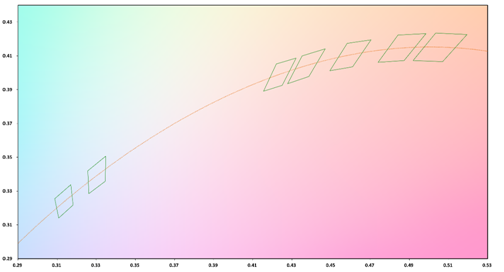
Less is more - YUJILEDS® releases its 3rd generation of chromaticity bin
Tighter chromaticity tolerance is always pursued by LED manufacturers since color consistency is getting more and more important. A general method is keeping the SDCM (Standard Deviation Color Matching) as a large scale, then divide it into small sections to make each with tight chromaticity tolerance, figure 1 shows the typical method based on Energy star ANSI C78.376.

Figure 1 – Typical chromaticity bin method on the market.
It is a balance solution that is almost suitable for all customers:
- Choose random bin combinations if you do not have specific requirement;
- Choose the bins close to the blackbody locus if you need to get as pure white light as possible;
- Choose the bins upward deviated from the blackbody locus if you need to simulate the D series standard illuminants;
……
However it also brings complicate work to consider, discuss and decide which bins to take, and there will be problems if the manufacturer does not have the bins you require, which means you will not get the suitable LEDs, or have to pay much more for the desired bins.
YUJILEDS® BC series LED also starts with the Energy star ANSI C78.376 standard, figure 2 shows the BC series 1st generation chromaticity bins.

Figure 2 – YUJILEDS® 1st generation of chromaticity bin for BC series.
With the development of our technology, gradually we are able control the tolerance even better, so the 2nd chromaticity bin is released in 2016 (Figure 3, trace my article on 17th May 2016). Vertical 50% tolerance is reduced comparing the 1st generation and the blackbody locus intersects the centers of all bins, which improves the purity of white light, meanwhile, the bin quantity is reduced from 4 to 2, simplifying the work a lot both for customers and us. Furthermore, the 2nd generation eliminates the possibility of the deviation from the blackbody locus substantially.

Figure 3 – YUJILEDS® 2nd generation of chromaticity bin for BC series.
We believe “Less is more”, after plenty of experiments and statistical analysis, now we are excited to release the 3rd generation of chromaticity bin (Figure 4), now there is only one bin and it optimizes the production cost, also makes bin solution extreme simply for customers.

Figure 4 – YUJILEDS® 3rd generation of chromaticity bin for BC series.
What is the difference between the 2nd and 3rd? Figure 5 shows the direct comparison, and you may feel strange of that there is no obvious difference, and 3rd is even larger than a single 2nd bin, then how do we say it is an upgraded solution?

Figure 5 – Comparison between YUJILEDS® 2nd & 3rd generation of chromaticity bin for BC series.
Indeed, you will not sense obvious difference on single LED between 2nd and 3rd, and 3rd is even larger than single 2nd bin, while the meaning will be completely different when we consider a mass production and integrated performance, like an LED cluster on flexible ribbon or PCB board.
As we should understand, with stable technical and quality control, the LED production should be compliant with Gaussian Distribution perfectly, especially for sufficient sample data. YUJILEDS® statistical data (Figure 6) also presents the same result, figure 6 shows an actual statistical on random 10,000pcs out of 1,000,000pcs total quantity based on the 2nd generation bin of 5600K, and we can find the conclusion as:
- 37% LEDs are within 5600K ± 50K;
- 63% LEDs are within 5600K ± 100K;
- 81% LEDs are within 5600K ± 150K;
- 90% LEDs are within 5600K ± 200K.
This high consistency phenomenon will be even more enhanced after integrating separated LED on a PCB.

Figure 6 – YUJILEDS® statistical data on CCT distribution of BC 2nd generation 5600K chromaticity bin.
The 2nd bin is nominal 5600K ± 300K, while the 3rd is nominal 5600K ± 200K, which means the horizontal bin range is reduced by 33%, then the actual CCT distribution should be reduced accordingly as well, our statistical data shows the expected results (Figure 7):
- 40% LEDs are within 5600K ± 50K;
- 65% LEDs are within 5600K ± 100K;
- 78% LEDs are within 5600K ± 150K;
- 99% LEDs are within 5600K ± 200K.
Likewise the conssitency will be ever better when integrating the LEDs on a PCB.

Figure 7 – YUJILEDS® statistical data on CCT distribution of BC 3rd generation 5600K chromaticity bin.
Now it is available for making the 3rd generation bin for BC series 2835L LED, but it is only meaningful at a certain of production quantity, so we will still keep the 2nd generation as our standard bin.
CRI is an important but only single dimension that describes lighting quality, we are always thinking about comprehensive solutions to solve the application-side problems, less is more but the "less" contains many thoughts and insistence.
